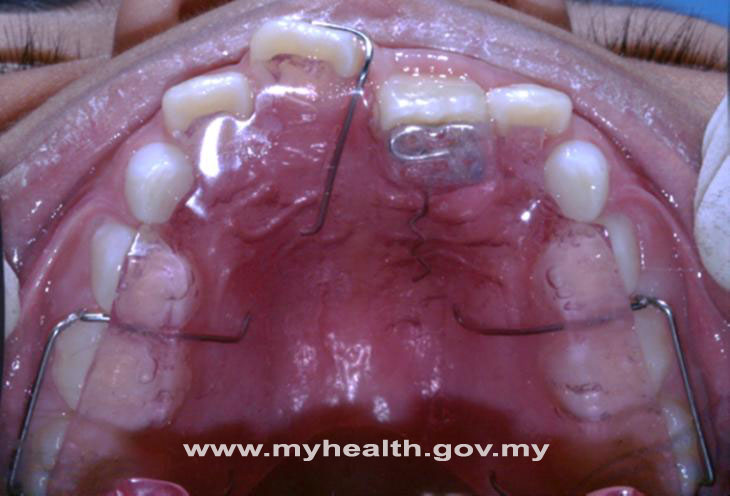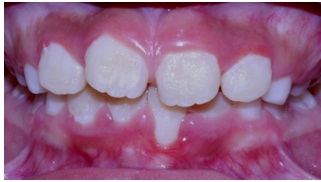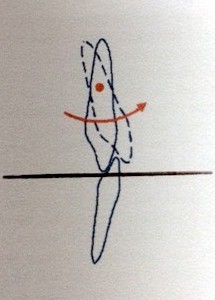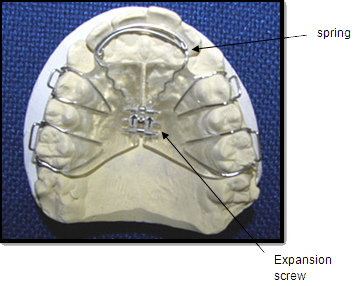Removable appliance is one of several types of devices used in orthodontic treatment; the others are fixed appliance, functional appliance and extra-oral device. Nowadays, the use of removable appliance is limited due to its unreliability in achieving satisfactory treatment outcome.
Removable appliance can be of benefit in some cases, especially in young patients who are in the mixed dentition. The removable appliance can be a very useful device in the treatment young patients with poor bite (Figure 1). This appliance is not suitable for adult patients.
Removable appliances that are used for growth modification (functional appliance) and retainers (a removable brace after active orthodontic treatment) will be discussed under separate sections and will not be discussed here.
Figure 1: A poor bite treated successfully with upper removable appliance
What are removable appliances?
Removable appliance (also known as removable brace/removable plate) is an appliance that is not fixed to the teeth and can be removed by the patient for the purpose of cleaning. It is usually used to correct problems with the bite. It can also be used as a space maintainer, when there’s an early loss of primary teeth due to decay. Removable appliance can also be used in combination with fixed appliance and headgear. However, removable appliance is unable to perform complex tooth movement on its own.
Removable appliance is more commonly fitted in the upper dental arch and it consists of an acrylic (plastic) plate, and wire components for tooth movement as well as retention of the appliance in the mouth (Figure 2).
Lower removable appliance is rarely used as it is difficult for the patient to tolerate due to encroachment of the appliance into the tongue space. Moreover, the appliance doesn’t hold well in the mouth compared to the upper removable appliance.

Figure 2: An upper removable appliance in the mouth
How do removable appliances work?
The removable appliance acts by simple tipping of the crown of the tooth/teeth to be moved (Figure 3). This is achieved by utilizing spring(s) of various designs constructed on a wire (Figure 4).
In some cases, the upper removable appliance can be used to expand the upper dental arch. The patient is instructed to turn an expansion screw that is in the removable appliance (Figure 4).
Figure 3: Tipping of tooth about a fulcrum (red dot) close to the middle of the tooth
Figure 4: Expansion screw in the middle of the upper removable appliance
What are the advantages and disadvantages of removable appliances?
This appliance is generally easy to clean as it can be removed by the patient. It can also be removed by patient for sports and social functions; thus, it has a higher acceptability by the patient. The other advantage is that the cost of making the appliance is low compared to that of fixed appliance.
The disadvantage of removable appliance is that because it requires patient co-operation, the appliance may be left out by the patient and thus, treatment success will be affected. Only tilting movement is achievable with this appliance, therefore the scope of its use is limited. The appliance may also affect speech, especially if it is ill-fitting.
Can I eat normally?
Yes, you will still be able to eat normally after the removable appliance is fitted. It is important that the appliance is worn even while you are eating and only removed briefly for cleaning after each meal. However, sugary foods/drinks should be reduced and avoided between meals, because the sugar may be trapped in the components of the removable appliance and risk damage to the teeth. Hard and chewy foods such as apples and chocolate bars should also be avoided as they can damage the appliance.
Will it be painful?
There is likely to be some tightness and discomfort in the first 3-5 days each time after the removable appliance is adjusted. It usually gets better after that. However, it is important that you keep wearing the appliance; otherwise the discomfort will set in again for another 3-5 days each time you resume wearing the appliance. If wearing it is really uncomfortable over a longer period of time then remove the appliance, and at the next visit to the orthodontist, point out to him/her where the problem area is.
How about tooth brushing?
You have to brush your teeth at least twice a day with fluoride toothpaste as you would normally. It is also important that you carry a toothbrush with you so that you can clean the appliance after meals. Take the appliance out and brush it with a little toothpaste over a sink filled with water. Be gentle and careful not to damage the wires when brushing the appliance.
How long does the treatment last?
Typically removable appliance is worn for 6-9 months to achieve its goals. However, if there are issues with co-operation and breakages, the treatment time will be increased.
Can I play sports with the appliance in my mouth?
You should remove your appliance for any contact sports, swimming or roller skating and keep it in a protective box. Do not place your appliance in your pocket as it may be damaged. A gumshield should be worn in place of a removable appliance to protect your teeth and gums during contact sports.
What happens if my appliance breaks or if I lose it?
You should contact the orthodontic clinic and request for an appointment as soon as possible to avoid further delay in the progress of treatment. There may be a fee involved in the repair or replacement of the appliance.
How often will I need to see the orthodontist after I get the removable appliance?
You will be reviewed every 4-6 weeks during treatment for the appliance to be adjusted. It is important that you attend the appointments.
Conclusion
Removable appliances are limited in their use in orthodontics but they can be a simple and inexpensive treatment option in properly selected cases.
References
- Ward S & Read MJ (2004). The contemporary use of removable orthodontic appliances. Dent Update 31(4): 215-28.
- British Orthodontic Society Patient Information Leaflet on Removable Appliances.
| Last Reviewed | : | 28 August 2020 |
| Writer | : | Dr. Yeoh Chew Kit |
| Accreditor / Reviewer | : | Dr. Hjh. Rashidah bt. Dato’ Hj. Burhanudin |











